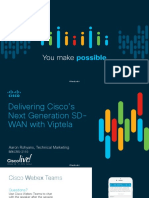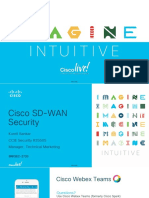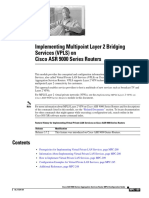Network Design Considerations in A Blade Server Environment - LAN & Storage
Network Design Considerations in A Blade Server Environment - LAN & Storage
Uploaded by
jeffgrantinctCopyright:
Available Formats
Network Design Considerations in A Blade Server Environment - LAN & Storage
Network Design Considerations in A Blade Server Environment - LAN & Storage
Uploaded by
jeffgrantinctOriginal Title
Copyright
Available Formats
Share this document
Did you find this document useful?
Is this content inappropriate?
Copyright:
Available Formats
Network Design Considerations in A Blade Server Environment - LAN & Storage
Network Design Considerations in A Blade Server Environment - LAN & Storage
Uploaded by
jeffgrantinctCopyright:
Available Formats
Network Design
Considerations in a Blade
Server Environment - LAN &
Storage
Session Number-BRKDCT-2869
Session_ID
Presentation_ID © 2008 Cisco Systems, Inc. All rights reserved. Cisco Public 2
© 2006, Cisco Systems, Inc. All rights reserved. 1
Presentation_ID.scr
Session Abstract
This session will cover design considerations for
blade server centric deployments. It will cover
interconnect considerations and topology options
for both LAN and storage technologies. Key
Blade Server specific features will be covered
along with installation instructions. Various
deployment scenarios will be described with pros
and cons for each design. Tools for simplifying
deployment will be described and demonstrated.
BRKDCT-2869 © 2008 Cisco Systems, Inc. All rights reserved. Cisco Public 3
Session Objectives
After completing this session you will be able to:
Understand the architecture and deployment for the Blade Switches
Understand topology options
Identify key edge features and IOS commands
Manage and monitor Ethernet Blade Switches via Device Manager
and CNA
Understand Key Fibre Channel Edge features and Architecture
BRKDCT-2869 © 2008 Cisco Systems, Inc. All rights reserved. Cisco Public 4
© 2006, Cisco Systems, Inc. All rights reserved. 2
Presentation_ID.scr
Outline
Network Design for Blade Servers
– DC Access Options for Blade Switchess: Pass-thru, ToR or Integrated Switch
– L2 vs L3 inside Blade Enclosure
– Single vs Two tier Access
– Services in a Blade Server deployment
– NIC teaming designs
– Virtual Server Deployment on bladeservers
Architectural Considerations for VBS Technology
– Overview & Benefits of Virtualization Technology
– Deployment scenarios – Pros & Cons
SAN
– Key issues faced by customers
– Solutions: NPV, FlexAttach
BRKDCT-2869 © 2008 Cisco Systems, Inc. All rights reserved. Cisco Public 5
View of Data Center Networking
The BIG Picture
WAN
LAN MAN
Integrated Network Services
Server Balancing
VPN Termination Enterprise Now Inside BladeSystem
LAN/MAN/WAN
SSL Termination
Switching
Firewall Services
Intrusion Detection
Multiprotocol Integrated Virtualization Services
Integrated Storage Services
Gateway V Server Virtualization
Virtual Fabrics (VSANs) Services Virtual I/O
Storage Virtualization
Grid/Utility Computing
Enterprise Server Fabric
Topspin
Data Replication Svcs Low Latency
SAN Switching Switching
Family
RDMA Services
Fabric Routing Svcs Clustering
High End Tape Drive Mid-Tier Tier 1 Tier 2 Tier 3
Disk Storage Storage Storage Servers Servers Servers
BRKDCT-2869 © 2008 Cisco Systems, Inc. All rights reserved. Cisco Public 6
© 2006, Cisco Systems, Inc. All rights reserved. 3
Presentation_ID.scr
Design with Pass-Thru Module and
Modular Access Switch
Modular
Cable density Access Blade Server
Switches Rack
Rack example:
Four Enclosures Per Rack
Up to 16 servers per enclosure
32 LOMs + 16 Service NICs per enc.
192 available access ports
Requires structured cabling to support
192 connections/blade rack
Single pair of access switches supports
12 blade server enclosures (three racks)
Gigabit Ethernet Connections
BRKDCT-2869 © 2008 Cisco Systems, Inc. All rights reserved. Cisco Public 7
Design with Pass-Thru Module and
Modular Access Switch
Does this look Manageable? How to I find and replace bad cable?
BRKDCT-2869 © 2008 Cisco Systems, Inc. All rights reserved. Cisco Public 8
© 2006, Cisco Systems, Inc. All rights reserved. 4
Presentation_ID.scr
Design with Pass-Thru Module and
Top of the Rack (TOR) Switches
High Cable density within the rack Aggregation Layer
High capacity uplinks provide
aggregation layer connectivity
Rack example:
10 GigE
Up to Four blade enclosures/rack Uplinks
Up to 128 cables for server traffic
Up to 64 cables for Server management
Up to four rack switches support local blade
servers
Up to two switches for server management
ports
Requires up to 192 cables within the rack
BRKDCT-2869 © 2008 Cisco Systems, Inc. All rights reserved. Cisco Public 9
Design with Blade Switches
Reduces cables within the rack Aggregation Layer
High capacity uplinks provide
aggregation layer connectivity
Rack example:
Up to Four blade enclosures/rack 10 GigE
Or GE
Two switches per enclosure
Uplinks
Either 8 GE or 1 10GE uplink per switch
Between 8 and 64 cables/fibers per rack
Reduces number of cables within the rack
but increases the number of uplinks
compared to ToR solution
Based on cable cost 10GE from Blade
Switch is a better option.
BRKDCT-2869 © 2008 Cisco Systems, Inc. All rights reserved. Cisco Public 10
© 2006, Cisco Systems, Inc. All rights reserved. 5
Presentation_ID.scr
Design with Virtual Blade Switches
Removes Cables from Rack Aggregation Layer
High capacity uplinks provide
aggregation layer connectivity
Rack example:
Up to Four blade enclosures/rack 10 GigE
Or GE
Up to 64 Servers per rack
Uplinks
Two switches per enclosure
One Virtual Blade Switch per Enclosure
Two or Four 10GE uplinks per Rack
Reduces number of Access Layer
switches by factor of 8
Allows for local Rack traffic to stay within
the Rack
BRKDCT-2869 © 2008 Cisco Systems, Inc. All rights reserved. Cisco Public 11
Networking in a Data Center
Each Layer Has a Distinct Role in the Network
• Layer 3 Core
Core • High Speed / Bandwidth
• High Availability
• Layer 2/3 Edge
• Data Center Service Integration
Aggregation – SSL termination, Load Balancer
– Firewall, IPS/ IDS, DOS Mitigation
– Caching
– Traffic Analysis
Access
• High Perf Server Connectivity
• Port Density
• Partitioning with VLANs
• Layer 2 resiliency with STP
BRKDCT-2869 © 2008 Cisco Systems, Inc. All rights reserved. Cisco Public 12
© 2006, Cisco Systems, Inc. All rights reserved. 6
Presentation_ID.scr
Layer 2 Access and Layer 3 Access Compared
Aggregation Aggregation
Rapid PVST+, or PVST+
OSPF, EIGRP
trunks L3 links
Access
Access
Layer 2
Layer 3
The Choice of one design versus the other one has to do with:
Layer 2 loops being more difficult to manage than Layer 3 loops
Convergence time, Link Utilization, Specific Application Requirements
Requirements of NIC teaming and Clustering
BRKDCT-2869 © 2008 Cisco Systems, Inc. All rights reserved. Cisco Public 13
When is Layer 2 Adjacency Required?
Meeting Server Farm Application Requirements
Clustering: applications MS-Windows
often execute on multiple Advanced
Server
servers clustered to Clustering
appear as a single device.
Common for HA, Load Linux
Balancing and High Beowulf or
Performance computing proprietary
requirements. (Windows clustering
(HPC)
2003 Advanced Server,
Linux Beowulf)
NIC teaming software
typically requires layer 2 AFT
adjacency SFT
ALB
BRKDCT-2869 © 2008 Cisco Systems, Inc. All rights reserved. Cisco Public 14
© 2006, Cisco Systems, Inc. All rights reserved. 7
Presentation_ID.scr
Blade NIC Teaming Configurations
Network Fault Tolerance (NFT)
Typical referred to as Active/Standby
y
ar
nd
Used when server sees two or more upstream switches
co
Pr
im
Se
NIC connectivity is PREDEFINED with built-in switches and
ar
y
may limit NIC configuration options
Transmit Load Balancing (TLB)
ry
Primary adapter transmit and receives
a
nd
Secondary adapters transmit only
co
Pr
im
Se
Rarely used
ar
y
Switch Assisted Load Balancing (SLB)
Often referred to as Active/Active
Server must see same switch on all member NICs
GEC/802.3ad
Increased throughput
Available with VBS switches Active
Standby
BRKDCT-2869 © 2008 Cisco Systems, Inc. All rights reserved. Cisco Public 15
Datacenter Access Evolution
Customers Have Two Options with Blade Servers
Create Two level Access Layer Maintain Single Access Layer
Core Core
or
Aggregation Aggregation
Access Access
- Existing Investment/Capacity in Aggregation/Access Layer
Decision Based on: - Size of Spanning Tree Domain
- Latency
BRKDCT-2869 © 2008 Cisco Systems, Inc. All rights reserved. Cisco Public 16
© 2006, Cisco Systems, Inc. All rights reserved. 8
Presentation_ID.scr
Blade Server Access Topologies
Different Alternatives:
V-Topology U-Topology Trunk-Failover Topology
• Very Popular Topology • Not as Popular • Maximum Bandwidth
available
• Some Bandwidth
not available • Needs NIC Teaming
BRKDCT-2869 © 2008 Cisco Systems, Inc. All rights reserved. Cisco Public 17
Reducing STP Complexity with Integrated Switching
Higher Resiliency with “Layer 2 Trunk Failover”
Typical Blade Network Topologies
L3
Switches
Link Link
State Cisco Blade State
Group 1 Switches Group 1
Blade Server Chassis Blade Server Chassis
FEATURE
• Map Uplink EtherChannel to downlink ports (Link State CUSTOMER BENEFIT
Group)
• Higher Resiliency / Availability
• If all uplinks fail, instantly shutdown downlink ports
• Reduce STP Complexity
• Server gets notified and starts using backup NIC/switch
BRKDCT-2869 © 2008 Cisco Systems, Inc. All rights reserved. Cisco Public 18
© 2006, Cisco Systems, Inc. All rights reserved. 9
Presentation_ID.scr
Flexlink Overview
Achieve Layer 2 resiliency without using STP
Access switches have backup links to Aggregation switches
Target of sub-100msec convergence upon forwarding link failover
Convergence time independent of #vlans and #mac-addresses
Interrupt based link-detection for Flexlink ports.
Link-Down detected at a 24msec poll.
No STP instance for Flexlink ports.
Forwarding on all vlans on the <up> flexlink port occurs with a
single update operation – low cost.
BRKDCT-2869 © 2008 Cisco Systems, Inc. All rights reserved. Cisco Public 19
Data Center / 3-Tier Network
Cat6K Cat6K
Core
Aggregation
Access
BRKDCT-2869 © 2008 Cisco Systems, Inc. All rights reserved. Cisco Public 20
© 2006, Cisco Systems, Inc. All rights reserved. 10
Presentation_ID.scr
(Mac address Move Notification) MMN
Overview
Achieve near sub-100 msec downtime for the
downstream traffic too, upon flexlink switchover.
Lightweight protocol : Send a MMN packet to [(Vlan1,
Mac1, Mac2..) (Vlan2, Mac1, Mac2..) ..] distribution
network.
Receiver parses the MMN packet and learns or moves
the contained mac-addresses. Alternatively, it can flush
the mac-address table for the vlans.
Receiver forwards packet to other switches.
BRKDCT-2869 © 2008 Cisco Systems, Inc. All rights reserved. Cisco Public 21
Flexlink MMN Performance –
Timings
BRKDCT-2869 © 2008 Cisco Systems, Inc. All rights reserved. Cisco Public 22
© 2006, Cisco Systems, Inc. All rights reserved. 11
Presentation_ID.scr
Flexlink Preemption
Flexlink enhanced to :
provide flexibility in choosing FWD link, optimizing available bandwidth utilization
User can configure Flexlink pair when previous FWD link comes back up :
Current FWD link continues
Æ Preemption mode Off
Previous FWD link preempts the current and begins FWD instead
Æ Preemption mode Forced
Higher bandwidth interface preempts the other and goes FWD
Æ Preemption mode Bandwidth
Note: By default, flexlink preemption mode is OFF
When configuring preemption delay:
user can specify a preemption delay time (0 to 300 sec)
default preemption delay is 35 secs
Preemption Delay Time :
Once the switch identifies a Flexlink preemption case, it waits an amount of <preemption
delay> seconds before preempting the currently FWD Flexlink interface.
BRKDCT-2869 © 2008 Cisco Systems, Inc. All rights reserved. Cisco Public 23
Flexlink Configuration Commands
CBS3120-VBS-TOP#config t
Enter configuration commands, one per line. End with CNTL/Z.
CBS3120-VBS-TOP(config)#int po1
CBS3120-VBS-TOP(config-if)#switchport backup int po 2
CBS3120-VBS-TOP(config-if)#
CBS3120-VBS-TOP#show interface switchport backup detail
Switch Backup Interface Pairs:
Active Interface Backup Interface State
------------------------------------------------------------------------
Port-channel1 Port-channel2 Active Up/Backup Down
Preemption Mode : off
Bandwidth : 20000000 Kbit (Po1), 10000000 Kbit (Po2)
Mac Address Move Update Vlan : auto
CBS3120-VBS-TOP#
BRKDCT-2869 © 2008 Cisco Systems, Inc. All rights reserved. Cisco Public 24
© 2006, Cisco Systems, Inc. All rights reserved. 12
Presentation_ID.scr
Outline
Network Design for Blade Servers
– DC Access Options for Blade Switchess: Pass-thru, ToR or Integrated Switch
– L2 vs L3 inside Blade Enclosure
– Single vs Two tier Access
– Services in a Blade Server deployment
– NIC teaming designs
– Virtual Server Deployment on bladeservers
Architectural Considerations for VBS Technology
– Overview & Benefits of Virtualization Technology
– Deployment scenarios – Pros & Cons
SAN
– Key issues faced by customers
– Solutions: NPV, FlexAttach
BRKDCT-2869 © 2008 Cisco Systems, Inc. All rights reserved. Cisco Public 25
Cisco Catalyst Virtual Blade Switch
Topology Highlighting Key Benefits
Access Layer (Virtual Blade Switch) Distribution Layer
Mix-n-match
GE & 10GE
switches
Local Traffic
doesn’t go to
distribution
switch
Higher
Resiliency With VSS on Cat
with 6K, all links
Etherchannel utilized
Single Switch / Node Greater Server BW –
(for Spanning Tree or via Active-Active
Layer 3 or Server Connectivity
Management)
BRKDCT-2869 © 2008 Cisco Systems, Inc. All rights reserved. Cisco Public 26
© 2006, Cisco Systems, Inc. All rights reserved. 13
Presentation_ID.scr
“Multiple Deployment Options for Customers”
Caters to Different Customer Needs
Benefits
Common Scenario
Cost Effective
Single Virtual Blade switch per rack
Entire rack can be deployed with as
little as two 10 GE uplinks or two GE
Etherchannels
Allows for Active/Active NIC teams
Creates a single router for entire rack
if deploying L3 on the edge
Keeps Rack traffic in the Rack
Design Considerations
Ring is limited to 64 Gbps
May cause Oversubscription
BRKDCT-2869 © 2008 Cisco Systems, Inc. All rights reserved. Cisco Public 27
“Multiple Deployment Options for Customers”
Caters to Different Customer Needs
Benefits
Separate VBS divide Left/Right switches
More resilient
Provides more Ring capacity since two
rings per Rack
Design Considerations
Requires more Uplinks per Rack
Servers can not form A/A NIC teams
BRKDCT-2869 © 2008 Cisco Systems, Inc. All rights reserved. Cisco Public 28
© 2006, Cisco Systems, Inc. All rights reserved. 14
Presentation_ID.scr
“Multiple Deployment Options for Customers”
Caters to Different Customer Needs
Benefits
Allows for 4 NICs per server
Can Active/Active Team all 4 NICs
More Server Bandwidth
Design Considerations
Creates smaller Rings
Requires more Uplinks
May Increase Traffic on each Ring
BRKDCT-2869 © 2008 Cisco Systems, Inc. All rights reserved. Cisco Public 29
Additional Options
By combining above three scenarios, the user can:
– Deploy up to 8 switches per enclosure
– Build smaller Rings with fewer Switches
– Split VBS between LAN on Motherboard (LOM) and
Daughter Card Ethernet NICs
– Split VBS across racks (See next slide)
– Connect unused uplinks to other Devices such as additional
Rack Servers or Appliances such as storage
BRKDCT-2869 © 2008 Cisco Systems, Inc. All rights reserved. Cisco Public 30
© 2006, Cisco Systems, Inc. All rights reserved. 15
Presentation_ID.scr
Proper VBS Ring Configuration
Each offer a full ring, could be built with 1 meter cables, and looks similar – But:
Certain designs could lead to a split ring if an entire enclosure is powered down
For “No” example, in the 4 enclosure example, if enclosure 3 had
power removed you would end up with two rings, one made up of Yes
No
the switches in enclosures 1 and 2, and one made up of the
switches in enclosure 4. This, at a minimum would leave each
VBS contending for the same IP address, and remote switch ENC 4
management would become difficult
No Yes
The “Yes” examples
also have a better
chance of
ENC 3
maintaining
connectivity for the
No Yes
servers in the event
a ring does get
completely split due
to multiple faults ENC 2
Cable Lengths are 0.5,
1.0 and 3.0 Meter. The
1.0 Meter cable ships
standard
ENC 1
BRKDCT-2869 © 2008 Cisco Systems, Inc. All rights reserved. Cisco Public 31
Virtual Blade Switch across Racks
VBS cables are limited to max of 3 meters
Insure that switches are not isolated in case of failure of switch or enclosure
May require cutting holes through side walls of Cabinets/Racks
~2 FT
~2 FT
BRKDCT-2869 © 2008 Cisco Systems, Inc. All rights reserved. Cisco Public 32
© 2006, Cisco Systems, Inc. All rights reserved. 16
Presentation_ID.scr
Most Common Deployment Scenario
Straight forward configuration
Ensure uplinks are spread across switches and enclosures
If using EC, make sure members are not in same enclosure
By using RSTP and EC, recovery time on failure is minimized
Make Master Switch (and Alternate) are not Uplink switches
Use FlexLinks if STP is not desired
Aggregation
Layer
Core
Layer
BRKDCT-2869 © 2008 Cisco Systems, Inc. All rights reserved. Cisco Public 33
Deployment Example
Switch Numbering 1 to 8, left to Right, Top to Bottom
Master Switch is Member 1
Alternate Masters will be 3,5,7
Uplink Switches will be Members 2,4,6,8
1 2
10 GE ECs from 2,4 and 6,8 will be used
3 4
RSTP will be used
User Data VLANs will be interleaved 5 6
7 8
BRKDCT-2869 © 2008 Cisco Systems, Inc. All rights reserved. Cisco Public 34
© 2006, Cisco Systems, Inc. All rights reserved. 17
Presentation_ID.scr
Configuration Commands
switch 1 priority 15 Å Sets Sw 1 to pri master
switch 3 priority 14 Å Sets Sw 3 to sec master
switch 5 priority 13 Å Sets Sw 5 to 3rd master
switch 7 priority 12 Å Sets Sw 7 to 4th Master
spanning-tree mode rapid-pvst Å Enables Rapid STP
vlan 1-10 Å Configures VLANs
state active
interface range gig1/0/1 – gig1/0/16
switchport access vlan xx Å Assign ports to VLANs
BRKDCT-2869 © 2008 Cisco Systems, Inc. All rights reserved. Cisco Public 35
Configuration Commands
interface range ten2/0/1, ten4/0/1
switchport mode trunk
switchport trunk allowed vlans 1-10
channel group 1 mode active
interface range ten6/0/1, ten8/0/1
switchport mode trunk
switchport trunk allowed vlans 1-10
channel group 2 mode active
interface po1
spanning-tree vlan 1,3,5,6,7,9 port-priority 0
spanning-tree vlan 2,4,6,8,10 port-priority 16
interface po2
spanning-tree vlan 1,3,5,6,7,9 port-priority 16
spanning-tree vlan 2,4,6,8,10 port-priority 0
BRKDCT-2869 © 2008 Cisco Systems, Inc. All rights reserved. Cisco Public 36
© 2006, Cisco Systems, Inc. All rights reserved. 18
Presentation_ID.scr
7 Rules to Live by for EtherChanneling
1. Split links across line cards on 6K side – prevents against Line
Card Outage
2. Split across 6Ks if using VSS - prevents against 6K outage
3. Split links across members on blade side if using VBS - prevents
against blade switch outage
4. Split links across Blade Enclosures if possible – prevents
against enclosure outage
5. Split VLANs across ECs for load balancing – prevents idle ECs.
6. Chose appropriate EC load balancing algorithm – example:
Blade servers generally have even number MAC addresses
7. Last but Not least, monitor your ECs - Only way to know if you
need more BW or Better EC load balance
BRKDCT-2869 © 2008 Cisco Systems, Inc. All rights reserved. Cisco Public 37
Device Manager Screen Shot
• Embedded HTML server
• Built into each Ethernet Blade Switch
• Provides Initial Configuration
• Simple Monitoring Tool
BRKDCT-2869 © 2008 Cisco Systems, Inc. All rights reserved. Cisco Public 38
© 2006, Cisco Systems, Inc. All rights reserved. 19
Presentation_ID.scr
CNA Screenshot – Topology View
BRKDCT-2869 © 2008 Cisco Systems, Inc. All rights reserved. Cisco Public 39
CNA Screenshot – Front Panel View
BRKDCT-2869 © 2008 Cisco Systems, Inc. All rights reserved. Cisco Public 40
© 2006, Cisco Systems, Inc. All rights reserved. 20
Presentation_ID.scr
Catalyst 6500 – Virtual Switching
What are the benefits?
VSS Benefits Network View (Logical)
L3 Distribution
• Single point of configuration and
managements
• Multi Chassis EtherChannel (MEC)
for active/active uplinks (No STP
Loops)
• Virtual Switch presents itself as a
single device consistently upstream
and downstream
MEC
• All PFC-based features handled in
hardware (multicast and unicast)
• Fully functional at either L2 or L3
• 50% Reduction in Routing Protocol
Neighbors = better scalability!
• VBS allows P2P with single EC Blade Switch Access Layer
BRKDCT-2869 © 2008 Cisco Systems, Inc. All rights reserved. Cisco Public 41
Catalyst 6500 – Virtual Switch Link
(VSL) Hardware / Software Requirement
Physical View Minimum Requirement
L3 Distribution
Sup720-10GE
VSL Interconnect
WS-X6708-10GE
Sup720-10GE DFC3C/CXL
Software:
>=12.2 RLS6
Access Layer Equipment:
Any device with
User/Server Access EtherChannel support
BRKDCT-2869 © 2008 Cisco Systems, Inc. All rights reserved. Cisco Public 42
© 2006, Cisco Systems, Inc. All rights reserved. 21
Presentation_ID.scr
Outline
Network Design for Blade Servers
– DC Access Options for Blade Switchess: Pass-thru, ToR or Integrated Switch
– L2 vs L3 inside Blade Enclosure
– Single vs Two tier Access
– Services in a Blade Server deployment
– NIC teaming designs
– Virtual Server Deployment on bladeservers
Architectural Considerations for VBS Technology
– Overview & Benefits of Virtualization Technology
– Deployment scenarios – Pros & Cons
SAN
– Key issues faced by customers
– Solutions: NPV, FlexAttach
BRKDCT-2869 © 2008 Cisco Systems, Inc. All rights reserved. Cisco Public 43
SAN Storage Topology
Blade Server
Integrated
Blade Switch
Director Class
SAN Switch
FC
BRKDCT-2869 © 2008 Cisco Systems, Inc. All rights reserved. Cisco Public 44
© 2006, Cisco Systems, Inc. All rights reserved. 22
Presentation_ID.scr
Key issues faced by customers
Not enough Domain IDs
World Wide Name (WWN) virtualization
BRKDCT-2869 © 2008 Cisco Systems, Inc. All rights reserved. Cisco Public 45
What is FlexAttach
Flexibility for Adds, Moves, and Changes
Blade Server
FlexAttach (Based on WWN NAT)
….
Blade N
Blade 1
Blade
New
Each Blade Switch F-Port assigned a
virtual WWN
Flex Attach
Blade Switch performs NAT operations on
No Blade
NPV real WWN of attached server
Switch Config
Change
Benefits
No SAN re-configuration required when
No Switch new Blade Server attaches to Blade
Zoning
Change
SAN Switch port
Provides flexibility for server
administrator, by eliminating need for
coordinating change management with
No Array
networking team
Configuration Storage
Change Reduces downtime when replacing failed
Blade Servers
BRKDCT-2869 © 2008 Cisco Systems, Inc. All rights reserved. Cisco Public 46
© 2006, Cisco Systems, Inc. All rights reserved. 23
Presentation_ID.scr
What is FlexAttach?
Creation of virtual PWWN for host initiators
Allows Server Administrative tasks with minimal
involvement of Storage Administrators
Pre-configure server for SAN access
Replacing Server HBA(s)
Replace Server HBA on same port
Moving blade server or server around the fabric
Can move blade server to another slot in same chassis
Can move blade server to another slot in another chassis
(has to be in the same physical SAN fabric)
BRKDCT-2869 © 2008 Cisco Systems, Inc. All rights reserved. Cisco Public 47
NPV Brief Overview
Core Switch
Login Process for NP-port
NP-port first does FLOGI and PLOGI into
the core to register into the FC Name
Server (Cisco PWWN)
Must be NPIV capable
Any subsequent login from NPV switch
will do FDISC to the FC Name Server F F
VSAN Membership
Core switch interface and NP switch NP NP
interface must have VSAN match
NPV Edge Switch
Servers on NPV switch must reside on a
VSAN that matches one or more NP
uplink’s VSAN F F
Login Process for End Devices PWWN1 PWWN2
Server login as FLOGI
NPV switch converts FLOGI to FDISC
PWWN of server gets registered in FC
Name Server
BRKDCT-2869 © 2008 Cisco Systems, Inc. All rights reserved. Cisco Public 48
© 2006, Cisco Systems, Inc. All rights reserved. 24
Presentation_ID.scr
FlexAttach – How does it work?
1. Interface fc1/1 is Core Switch (MDS or 3rd party switch with NPIV support)
FlexAttach enabled and
assigned vpwwn1
Server S1 is known by
2. Server S1 does FLOGI to vpwwn1 in the SAN
interface fc1/1
3. pwwn1 FLOGI is
rewritten to use vpwwn1 F
FLOGI
4. vpwwn1 FLOGI is port WWN of S1= vpwwn1
converted to FDISC to be NP
entered into FC Name NPV-FlexAttach pwwn rewrite rules
Server
F fc1/1 Æ vpwwn1
port WWN of S1 = pwwn1
N pwwn1
Server S1
BRKDCT-2869 © 2008 Cisco Systems, Inc. All rights reserved. Cisco Public 49
A Typical Virtualized Data Center
Network Is Even More Important
Virtualization
VirtualCenter NAS Storage enables SOA –
Management Server requires server
and Network
Mobility of VMs possible
Dynamic
ONLY thru Network
Provisioning
Ethernet
Network
VMotion
ESX Servers
Centralized Storage for
Multiple Network / Storage OS & data (SAN or
SAN connections Network NAS)
Hence, Network needs to be Highly
Resilient, Secure, Agile and Manageable SAN Storage
BRKDCT-2869 © 2008 Cisco Systems, Inc. All rights reserved. Cisco Public 50
© 2006, Cisco Systems, Inc. All rights reserved. 25
Presentation_ID.scr
Cisco VFrame DC Enables Dynamic Provisioning for
Virtualized Environments
Business Service
Management Monitoring
IBM Tivoli, HP Openview,
Orchestrate across
Mercury,
Tideway, BMC
BMC Patrol, CA Unicenter infrastructure resources
Platform for service
Management and Monitoring
abstraction
Integrate with other
management systems
Cisco VFrame Data Center
Network-Driven Service Orchestration
Virtualization Element Managers
Managers Cisco Fabric Manager, VMS, SOI Control
VMware VirtualCenter CiscoWorks, ANM Layer
SAN
NAS
Server Pool Network Pool Storage Pool
Data Center Networked Infrastructure
BRKDCT-2869 © 2008 Cisco Systems, Inc. All rights reserved. Cisco Public 51
VFrame Screenshot – Server Provisioning
BRKDCT-2869 © 2008 Cisco Systems, Inc. All rights reserved. Cisco Public 52
© 2006, Cisco Systems, Inc. All rights reserved. 26
Presentation_ID.scr
VFrame Screenshot – Network Provisioning
BRKDCT-2869 © 2008 Cisco Systems, Inc. All rights reserved. Cisco Public 53
VFrame Screenshot – VMWare Example
BRKDCT-2869 © 2008 Cisco Systems, Inc. All rights reserved. Cisco Public 54
© 2006, Cisco Systems, Inc. All rights reserved. 27
Presentation_ID.scr
In Summary
Blade server and switch architectures simplify your vary
your data center design
Blade Switches provide the same rich feature set as the
Aggregation and Core switches
Many options available for blade server integration into
the data center for both storage and
IP connectivity
Virtualization is a Key part of the Next Generation DC
BRKDCT-2869 © 2008 Cisco Systems, Inc. All rights reserved. Cisco Public 55
Q and A
BRKDCT-2869 © 2008 Cisco Systems, Inc. All rights reserved. Cisco Public 56
© 2006, Cisco Systems, Inc. All rights reserved. 28
Presentation_ID.scr
Other Data Center Sessions
BRKDCT-2823 The Server Switch, Demultiplexing Networks with a Unified Fabric
BRKDCT-2825 Nexus Architecture
BRKDCT-2840 Data Center Networking – Taking risk out of Layer 2 Interconnects
BRKDCT-2863 DC Migration & Consolidation Discovery Methodology
BRKDCT-2866 Data Center Architecture Strategy and Planning
BRKDCT-2867 Data Center Facilities Consideration in Designing and Building Networks
BRKDCT-2868 Network Integration of Server Virtualization - LAN & Storage
BRKDCT-2870 Data Center Virtualization Overview/Concepts
BRKDCT-3831 Advanced Data Center Virtualization
BRKRST-3470 Cisco Nexus 7000 Switch Architecture
BRKRST-3471 Cisco NXOS Software - Architecture and Deployment
LABDCT-2870 Cisco Nexus 7000 Series Lab
LABDCT-2871 I/O Consolidation using Fibre Channel over Ethernet
TECDCT-2887 Architecting Distributed, Resilient Data Centers
TECDCT-3873 Data Center Design Power Session
TECRST-2003 Cisco Nexus 7000 Series Technical Deep Dive
BRKDCT-2869 © 2008 Cisco Systems, Inc. All rights reserved. Cisco Public 57
Product Pages
For More information on Cisco Ethernet or FC Blades:
www.cisco.com/go/bladeswitch
For More information on VFrame Datacenter:
http://www.cisco.com/en/US/products/ps8463/index.html
For More information on Blade Server Partners:
DELL:
http://www.dell.com/content/products/compare.aspx/blade?c=us&cs=5
55&l=en&s=biz&~ck=mn
HP:
http://h18004.www1.hp.com/products/blades/components/c-class-
components.html
IBM:
http://www-03.ibm.com/systems/bladecenter/
BRKDCT-2869 © 2008 Cisco Systems, Inc. All rights reserved. Cisco Public 58
© 2006, Cisco Systems, Inc. All rights reserved. 29
Presentation_ID.scr
Recommended Reading
Continue your Cisco Live learning
experience with further reading
from Cisco Press
Check the Recommended Reading
flyer for other suggested books
http://www.ciscopress.com/bookstore/browse.asp?st=60113
Available Onsite at the Cisco Company Store
BRKDCT-2869 © 2008 Cisco Systems, Inc. All rights reserved. Cisco Public 59
Complete Your Online
Session Evaluation
Cisco values your input
Give us your feedback—we read
and carefully consider your scores
and comments, and incorporate
them into the content program
year after year
Go to the Internet stations located
throughout the Convention Center
to complete your session
evaluations
Thank you!
BRKDCT-2869 © 2008 Cisco Systems, Inc. All rights reserved. Cisco Public 60
© 2006, Cisco Systems, Inc. All rights reserved. 30
Presentation_ID.scr
BRKDCT-2869 © 2008 Cisco Systems, Inc. All rights reserved. Cisco Public 61
© 2006, Cisco Systems, Inc. All rights reserved. 31
Presentation_ID.scr
You might also like
- DZS GPON Technology Training Course - Session 3Document62 pagesDZS GPON Technology Training Course - Session 3Viet Linh50% (2)
- Learning SD-WAN with Cisco: Transform Your Existing WAN Into a Cost-effective NetworkFrom EverandLearning SD-WAN with Cisco: Transform Your Existing WAN Into a Cost-effective NetworkNo ratings yet
- SD WanDocument53 pagesSD WanAlisamiir100% (1)
- BRKSPG 2720Document80 pagesBRKSPG 2720Filipi TariganNo ratings yet
- VSS Cisco LiveDocument179 pagesVSS Cisco LiveF5 SupportNo ratings yet
- BRKSPG 2210 PDFDocument83 pagesBRKSPG 2210 PDFNhật Vỹ100% (1)
- Data Center Switching: Nexus 9000 Series SwitchesDocument23 pagesData Center Switching: Nexus 9000 Series SwitchesVIMAL KUMAR CHAUHANNo ratings yet
- MA BRKCAM-3002 284323 156-1 v1Document86 pagesMA BRKCAM-3002 284323 156-1 v1Corina SalamonNo ratings yet
- Fdocuments - in Cisco Live Data Center Design GuideDocument71 pagesFdocuments - in Cisco Live Data Center Design Guidezhu kechunNo ratings yet
- SEA WOLF Website 052023Document184 pagesSEA WOLF Website 052023para275No ratings yet
- BRKRST-2045 - WAN Architectures and Segmentation Innovations (WAN L3 Segmentation) 2018Document103 pagesBRKRST-2045 - WAN Architectures and Segmentation Innovations (WAN L3 Segmentation) 2018Michel HachemNo ratings yet
- DANOS-Vyatta Edition: For Disaggregated Cell Site GatewaysDocument5 pagesDANOS-Vyatta Edition: For Disaggregated Cell Site GatewaysБынзарь ДмитрийNo ratings yet
- BRKCRS 2110Document41 pagesBRKCRS 2110Vivek SDWANNo ratings yet
- CWAAS20S05Document152 pagesCWAAS20S05kayudo80No ratings yet
- BRKDCN 2218Document128 pagesBRKDCN 2218Alex10505No ratings yet
- Sdwan SecurityDocument85 pagesSdwan Securityommr8501No ratings yet
- BRKSDN 2333Document102 pagesBRKSDN 2333cool dude911No ratings yet
- SDWAN ShorthandDocument4 pagesSDWAN ShorthandSahil JoshiNo ratings yet
- Cisco BRKRST-2069Document98 pagesCisco BRKRST-2069Satam EmrithNo ratings yet
- BRKCRS 2110Document51 pagesBRKCRS 2110SEMİHNo ratings yet
- Local KnowledgeDocument40 pagesLocal KnowledgeJelena TodorovićNo ratings yet
- Nso 11Document72 pagesNso 11cool dude911No ratings yet
- Brkarc 1004Document80 pagesBrkarc 1004masterlinh2008No ratings yet
- DC-CCNA-Fabric_Path_ozdenDocument43 pagesDC-CCNA-Fabric_Path_ozdenardomsaNo ratings yet
- BRKSP 2551 1Document86 pagesBRKSP 2551 1ymmkghNo ratings yet
- PulseSecure OneSheet PSAHardwareDocument4 pagesPulseSecure OneSheet PSAHardwaretnhphuongNo ratings yet
- Brkent 2006Document102 pagesBrkent 2006ajay_ajuNo ratings yet
- Cisco BRKRST-2668 DeckDocument53 pagesCisco BRKRST-2668 DeckRoshan TejasNo ratings yet
- VMDC Design ConsiderationDocument34 pagesVMDC Design ConsiderationcspowerNo ratings yet
- Cisco Live Introduction To SRv6 uSID Technology-2Document129 pagesCisco Live Introduction To SRv6 uSID Technology-2wang wilsonNo ratings yet
- DGTL BRKCRS 1501Document41 pagesDGTL BRKCRS 1501Kevin HarperNo ratings yet
- BRKARC-2112 - 2019 BarcelonaDocument160 pagesBRKARC-2112 - 2019 BarcelonabruceNo ratings yet
- BRKARC-2881Document108 pagesBRKARC-2881pom.charles.chowNo ratings yet
- BRKRST-2068Case Study in Network Virtualisation UWADocument96 pagesBRKRST-2068Case Study in Network Virtualisation UWASupriyo SahaNo ratings yet
- Brkarc 2012 PDFDocument119 pagesBrkarc 2012 PDFbruceNo ratings yet
- Cisco SD-WAN Application BRKRST-2514Document47 pagesCisco SD-WAN Application BRKRST-2514Aaron Reyes SanchezNo ratings yet
- BRKARC-1006-SD-WAN Vedge and XE SD-WAN Platform Architecture Overview PDFDocument91 pagesBRKARC-1006-SD-WAN Vedge and XE SD-WAN Platform Architecture Overview PDFSandro100% (1)
- Unmaintained Design Icons - v2.0Document10 pagesUnmaintained Design Icons - v2.0asmeen419No ratings yet
- Atualização Cisco Meraki Secure SD-WANDocument60 pagesAtualização Cisco Meraki Secure SD-WANpaulo_an7381No ratings yet
- Cisco Connect Dubai Software Defined NetworkingDocument31 pagesCisco Connect Dubai Software Defined NetworkingegriaNo ratings yet
- End-to-End Network Slice Orchestration and AutomationDocument26 pagesEnd-to-End Network Slice Orchestration and AutomationNgô Đức ViệtNo ratings yet
- BRKXAR-2006Document27 pagesBRKXAR-2006Test TestNo ratings yet
- Presentation Title Meraki SD-WAN: A Global Solution For Distributed NetworksDocument54 pagesPresentation Title Meraki SD-WAN: A Global Solution For Distributed NetworksthimottiNo ratings yet
- Cisco Active Network Abstraction: BRKDEV-1051Document32 pagesCisco Active Network Abstraction: BRKDEV-1051jeffgrantinctNo ratings yet
- SD-WAN Solution Technology OverviewDocument48 pagesSD-WAN Solution Technology OverviewBillupsNo ratings yet
- Brkent 2108Document65 pagesBrkent 2108sachida.ddjrtNo ratings yet
- Cisco Live Cisco Validated Blueprint ArchitectureDocument57 pagesCisco Live Cisco Validated Blueprint Architecturewang wilsonNo ratings yet
- MPLS22LGDocument81 pagesMPLS22LGTerri DuranNo ratings yet
- Aci DC CiscoDocument71 pagesAci DC CiscoJuan Manuel CruzNo ratings yet
- UCL Data Centres Infrastructure Design: James Clements Emma Cardinal-RichardsDocument23 pagesUCL Data Centres Infrastructure Design: James Clements Emma Cardinal-RichardsAkram M. AlmotaaNo ratings yet
- Cisco Meraki MX Cloud Managed Security AppliancesDocument22 pagesCisco Meraki MX Cloud Managed Security AppliancesDmitri DicusarNo ratings yet
- Gcasr 9 KvplsDocument52 pagesGcasr 9 KvplsAbhishek gargNo ratings yet
- Introduction To SRv6 Microsid - BRKSPG-3058Document59 pagesIntroduction To SRv6 Microsid - BRKSPG-3058trungvietaNo ratings yet
- Brkewn 2034Document137 pagesBrkewn 2034GTest DrinkWaterNo ratings yet
- CVD IWANConfigurationFilesGuide FEB16Document280 pagesCVD IWANConfigurationFilesGuide FEB16Terry ZhaoNo ratings yet
- Implementing Data Center Services (Interoperability, Design and Deployment)Document31 pagesImplementing Data Center Services (Interoperability, Design and Deployment)jeffgrantinctNo ratings yet
- Cisco Virtual Update Cisco Sdwan ViptelaDocument55 pagesCisco Virtual Update Cisco Sdwan ViptelaSanjeev MoghaNo ratings yet
- Network Diagram Examples IconsDocument32 pagesNetwork Diagram Examples Iconshadyan hafizhNo ratings yet
- Brkopt 2102Document69 pagesBrkopt 2102cool dude911No ratings yet
- Internet Gateway Router Design Using Cisco ASR 1000 Series RoutersDocument8 pagesInternet Gateway Router Design Using Cisco ASR 1000 Series RoutersAnonymous SmYjg7gNo ratings yet
- Cisco Networks: Engineers' Handbook of Routing, Switching, and Security with IOS, NX-OS, and ASAFrom EverandCisco Networks: Engineers' Handbook of Routing, Switching, and Security with IOS, NX-OS, and ASANo ratings yet
- IEEE 802.3az Energy Efficient Ethernet: Build Greener NetworksDocument9 pagesIEEE 802.3az Energy Efficient Ethernet: Build Greener Networksplext0rNo ratings yet
- Self-Defending Network Support For PCI: BRKSEC-2008Document56 pagesSelf-Defending Network Support For PCI: BRKSEC-2008jeffgrantinctNo ratings yet
- Strategies and Tactics:: Application Troubleshooting SimplifiedDocument69 pagesStrategies and Tactics:: Application Troubleshooting SimplifiedjeffgrantinctNo ratings yet
- Inside The Perimeter: Six Steps To Improve Your Security MonitoringDocument43 pagesInside The Perimeter: Six Steps To Improve Your Security MonitoringjeffgrantinctNo ratings yet
- Understanding, Preventing, and Defending Against Layer 2 AttacksDocument61 pagesUnderstanding, Preventing, and Defending Against Layer 2 AttacksjeffgrantinctNo ratings yet
- Innovate The Steve Jobs WayDocument10 pagesInnovate The Steve Jobs WayVijayanand GaneshanNo ratings yet
- I/O Consolidation in The Data Center: BRKSAN-2821Document53 pagesI/O Consolidation in The Data Center: BRKSAN-2821jeffgrantinctNo ratings yet
- Monitoring and Mitigating Threats: BRKSEC-2004Document66 pagesMonitoring and Mitigating Threats: BRKSEC-2004jeffgrantinctNo ratings yet
- Ipv6 Security Threats and Mitigations: Brksec-2003Document61 pagesIpv6 Security Threats and Mitigations: Brksec-2003jeffgrantinctNo ratings yet
- Design and Implementation of Storage Media Encryption: BRKSAN-2893Document35 pagesDesign and Implementation of Storage Media Encryption: BRKSAN-2893jeffgrantinctNo ratings yet
- Advanced SAN Troubleshooting: Mike FraseDocument60 pagesAdvanced SAN Troubleshooting: Mike FrasejeffgrantinctNo ratings yet
- Teleconference: Demystifying NAC: Going Beyond Basic Admission ControlDocument25 pagesTeleconference: Demystifying NAC: Going Beyond Basic Admission ControljeffgrantinctNo ratings yet
- Emerging Threats: BRKSEC-2001Document49 pagesEmerging Threats: BRKSEC-2001jeffgrantinctNo ratings yet
- Introduction To Storage Area Networks (SAN) : BRKSAN-1701Document42 pagesIntroduction To Storage Area Networks (SAN) : BRKSAN-1701jeffgrantinctNo ratings yet
- DC Migration and Consolidation Discovery Methodology: BRKDCT-2863Document35 pagesDC Migration and Consolidation Discovery Methodology: BRKDCT-2863jeffgrantinctNo ratings yet
- Advanced SAN Design - Virtualization Technologies and Intelligent Applications Design ConsiderationsDocument40 pagesAdvanced SAN Design - Virtualization Technologies and Intelligent Applications Design ConsiderationsjeffgrantinctNo ratings yet
- Advanced Data Center Virtualization: BRKDCT-3831Document62 pagesAdvanced Data Center Virtualization: BRKDCT-3831jeffgrantinctNo ratings yet
- SAN Extension Design and Operation: BRKSAN-2704Document47 pagesSAN Extension Design and Operation: BRKSAN-2704jeffgrantinctNo ratings yet
- Vmware Integration: Brkdct-2868Document44 pagesVmware Integration: Brkdct-2868jeffgrantinctNo ratings yet
- Understanding The Lightweight Access Point Protocol (Lwapp) : White PaperDocument5 pagesUnderstanding The Lightweight Access Point Protocol (Lwapp) : White PaperjeffgrantinctNo ratings yet
- Optical Technology and Systems For The EnterpriseDocument89 pagesOptical Technology and Systems For The EnterprisejeffgrantinctNo ratings yet
- Implementing Data Center Services (Interoperability, Design and Deployment)Document31 pagesImplementing Data Center Services (Interoperability, Design and Deployment)jeffgrantinctNo ratings yet
- Lwap 1000 Ap Q&aDocument5 pagesLwap 1000 Ap Q&ajeffgrantinctNo ratings yet
- Leviton Power Solutions-2 To None in The Industry: "Protecting A Connected World"Document51 pagesLeviton Power Solutions-2 To None in The Industry: "Protecting A Connected World"jeffgrantinctNo ratings yet
- Introduction To Cisco'S Netflow Technology: Slide 1Document29 pagesIntroduction To Cisco'S Netflow Technology: Slide 1jeffgrantinctNo ratings yet
- Ethernet Switching With ArduinoDocument24 pagesEthernet Switching With ArduinoAsmir Azra MujagicNo ratings yet
- ABB Application Manual - Integrated Vision - 3HAC044251-en PDFDocument104 pagesABB Application Manual - Integrated Vision - 3HAC044251-en PDFRadu Babau100% (1)
- En-S6500 Ethernet Switches Main Slides ISSUE 1Document28 pagesEn-S6500 Ethernet Switches Main Slides ISSUE 1api-3758431100% (1)
- 2.7.6 Packet Tracer - Implement Basic ConnectivityDocument7 pages2.7.6 Packet Tracer - Implement Basic ConnectivityLiêm HuỳnhNo ratings yet
- Ds Agile 6.0 OfficialDocument8 pagesDs Agile 6.0 OfficialEver SmileNo ratings yet
- HelixNet IP Networking GuideDocument22 pagesHelixNet IP Networking GuidebelNo ratings yet
- Date Received 1st Submission Re-Submission Date Date Received 2nd SubmissionDocument12 pagesDate Received 1st Submission Re-Submission Date Date Received 2nd SubmissionCan Khuong Duy (BTEC HN)No ratings yet
- Cs Tcom RF 7800w High Capacity Los Radio Datasheet 0Document2 pagesCs Tcom RF 7800w High Capacity Los Radio Datasheet 0azizrakouchNo ratings yet
- Unit 6 Lab 6 - Creating PLC ProgramsDocument10 pagesUnit 6 Lab 6 - Creating PLC ProgramsCheikh DjimeraNo ratings yet
- Manual Switch OverTek OT 3407SVW UXDocument22 pagesManual Switch OverTek OT 3407SVW UXKovalski AndersonNo ratings yet
- ch1 QuesDocument8 pagesch1 QuessasamahalawyNo ratings yet
- (M7-TECHNICAL) Network and Internet SUNTAY TS03Document4 pages(M7-TECHNICAL) Network and Internet SUNTAY TS03202312595No ratings yet
- I. Multiple Choice (30 PTS.)Document3 pagesI. Multiple Choice (30 PTS.)Hanz AngeloNo ratings yet
- 12 - Network Devices or ComponentsDocument3 pages12 - Network Devices or ComponentsOmer107100% (1)
- Biaya Dasar Mini ISPDocument5 pagesBiaya Dasar Mini ISPUrang Solok Ba PacebookNo ratings yet
- Auditing Routers, Switches, and FirewallsDocument14 pagesAuditing Routers, Switches, and FirewallsTrafalgar S Topan0% (1)
- LC198 Hirschmann Industrial Ethernet EquipmentDocument1 pageLC198 Hirschmann Industrial Ethernet EquipmentAbdelilah CharboubNo ratings yet
- Cisco Catalyst 3850 Series Switches: Table 1Document16 pagesCisco Catalyst 3850 Series Switches: Table 1luixfoNo ratings yet
- Telecommunication PrinciplesDocument15 pagesTelecommunication PrinciplesSithija AlwisNo ratings yet
- RAB Portal FIK FEB FKB - Final RABDocument2 pagesRAB Portal FIK FEB FKB - Final RABbellsigmainsNo ratings yet
- 3.4.1.2 Skills Integration Challenge Instructions PDFDocument2 pages3.4.1.2 Skills Integration Challenge Instructions PDFVincent DuchateauNo ratings yet
- Features: Catalyst 3750 Metro Switch Software Configuration Guide OL-9644-10Document20 pagesFeatures: Catalyst 3750 Metro Switch Software Configuration Guide OL-9644-10Deisna RahmaningtyasNo ratings yet
- Optimising Your Mikrotik Layer2 Configuration: March 2019 © Jono Thompson Birchenallhowden LTDDocument100 pagesOptimising Your Mikrotik Layer2 Configuration: March 2019 © Jono Thompson Birchenallhowden LTDfabeltranmNo ratings yet
- Intro Opnet Modeler Lecture 16.0Document185 pagesIntro Opnet Modeler Lecture 16.0kostas_ntougias5453No ratings yet
- Brochure Icx 7150Document14 pagesBrochure Icx 7150jscerNo ratings yet
- ACTIVITY 1 - Investigating Places With Established Network ConnectionDocument3 pagesACTIVITY 1 - Investigating Places With Established Network ConnectionAngelyn RodisNo ratings yet
- DPDK ContrDocument196 pagesDPDK Contrbilawalaziz42No ratings yet
- TP Link Omada Eap660 HDDocument2 pagesTP Link Omada Eap660 HDTales PerondiNo ratings yet
- Cisco Catalyst 3550 SwitchDocument11 pagesCisco Catalyst 3550 SwitchAnis AhmedNo ratings yet

















































































































